Prevent Diabetes Problems: Keep Your Nervous System Healthy
On this page:
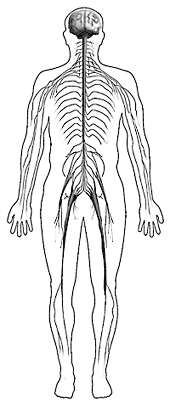 |
| High blood glucose can cause
nerve problems. |
What are diabetes problems?
Too much glucose (sugar) in the blood for a long time can cause diabetes problems. This high blood glucose (also called blood sugar) can damage many parts of the body, such as the heart, blood vessels, eyes, and kidneys. Heart and blood vessel disease can lead to heart attacks and strokes. You can do a lot to prevent or slow down diabetes problems.
This booklet is about nerve problems that can be caused by diabetes. You will learn the things you can do each day and during each year to stay healthy and prevent diabetes problems.
[Top]
What should I do each day to stay healthy with diabetes?
 |
Follow the healthy eating plan that you and your doctor or dietitian have worked out. |
 |
Be active a total of 30 minutes most days. Ask your doctor what activities are best for you. |
 |
Take your diabetes medicines at the same times each day. |
 |
Check your blood glucose every day. Each time you check your blood glucose, write the number in your record book. |
 |
Check your feet every day for cuts, blisters, sores, swelling, redness, or sore toenails. |
 |
Brush and floss your teeth and gums every day. |
 |
Don't smoke. |
[Top]
What can I do to prevent diabetes from damaging my nervous system?
Research has shown that people who kept their blood glucose close to normal were able to lower their risk of nerve damage.
Here is what you can do to prevent nerve damage:
- Keep your blood glucose as close to normal as you can.
- Limit the amount of alcohol you drink.
- Don't smoke.
- Take care of your feet (see "What can I do to take care of my feet?").
- Tell your doctor about any problems you have with
- your hands, arms, feet, and legs
- your stomach, bowels, or bladder
- Also tell your doctor if you
- have problems when you have sex
- cannot always tell when your blood glucose is too low
- feel dizzy when you go from lying down to sitting or standing
[Top]
What can I do to take care of my feet?
 |
Look at your feet every day to check for problems. |
- Wash your feet in warm water every day. Make sure the water is not too hot by testing the temperature with your elbow. Do not soak your feet. Dry your feet well, especially between your toes.
- Look at your feet every day to check for cuts, sores, blisters, redness, calluses, or other problems. Checking every day is even more important if you have nerve damage or poor blood flow. If you cannot bend over or pull your feet up to check them, use a mirror. If you cannot see well, ask someone else to check your feet.
- If your skin is dry, rub lotion on your feet after you wash and dry them. Do not put lotion between your toes.
- File corns and calluses gently with an emery board or pumice
stone. Do this after your bath or shower.
- Cut your toenails once a week or when needed. Cut toenails when they are soft from washing. Cut them to the shape of the toe and not too short. File the edges with an emery board. If you cannot cut your own toenails, ask someone who can or go to a foot doctor.
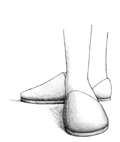 |
|
Always wear slippers or shoes to protect your feet. |
- Always wear shoes or slippers to protect your feet from injuries.
- Always wear socks or stockings to avoid blisters. Do
not wear socks or knee-high stockings that are too tight below
your knee.
- Wear shoes that fit well. Shop for shoes at the end of the
day when your feet are bigger. Break in shoes slowly. Wear
them 1 to 2 hours each day for the first 1 to 2 weeks.
- Make sure your doctor checks your feet at each checkup.
[Top]
What does my nervous system do?
Nerves carry messages back and forth between the brain and other parts of the body. All of your nerves together make up the nervous system.
Some nerves tell the brain what is happening in the body. For example, when you step on a tack, the nerve in your foot tells the brain about the pain. Other nerves tell the body what to do. For example, nerves from the brain tell your stomach when it is time to move food into your intestines.
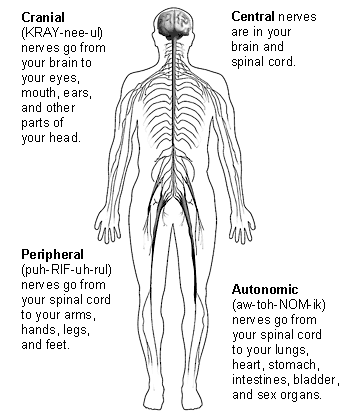 |
|
The nervous system has four main parts--cranial,
central, peripheral, and autonomic. Diabetes can damage the
peripheral, autonomic, and cranial nerves.
|
[Top]
How can diabetes hurt my nervous system?
Having high blood glucose for many years can damage the blood vessels that bring oxygen to some nerves. High blood glucose can also hurt the covering on the nerves. Damaged nerves may stop sending messages. Or they may send messages too slowly or at the wrong times. Diabetic neuropathy (ne-ROP-uh-thee) is the medical term for damage to the nervous system from diabetes.
[Top]
How can diabetes damage to the peripheral nerves affect me?
- Peripheral nerves go to the arms, hands, legs, and feet. Damage to these nerves can make your arms, hands, legs, or feet feel numb. Also, you might not be able to feel pain, heat, or cold when you should. You may feel shooting pains or burning or tingling, like "pins and needles." These feelings are often worse at night. They can make it hard to sleep. Most of the time these feelings are on both sides of your body, like in both of your feet. But they can be on just one side.
Peripheral nerve damage can change the shape of your feet. Foot muscles get weak and the tendons in the foot get shorter. You can get special shoes that are made to fit softly around your sore feet or feet that have changed shape. These special shoes help protect your feet. Medicare and other health insurance programs may pay for special shoes. Talk to your doctor about how and where to get these shoes.
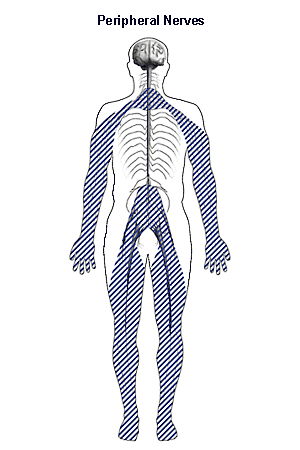 |
|
Peripheral nerves go from your spinal cord
to your arms, hands, legs, and feet.
|
[Top]
How can diabetes damage to the autonomic nerves affect me?
- Autonomic nerves help you know your blood glucose is low.
Some people take diabetes medicines that can accidentally make their blood glucose too low. Damage to the autonomic nerves can make it hard for them to feel the symptoms of hypoglycemia (hy-po-gly-SEE-mee-uh), also called low blood glucose.
This kind of damage is more likely to happen if you have had diabetes for a long time. It can also happen if your blood glucose has been too low very often.
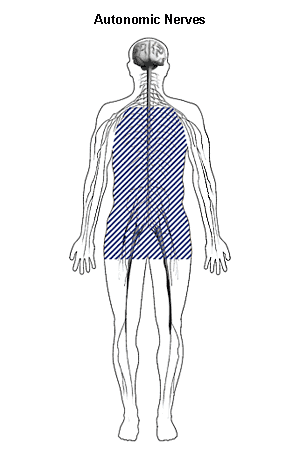 |
|
Autonomic nerves go from your spinal cord
to your lungs, heart, stomach, intestines, bladder, and sex
organs.
|
- Autonomic nerves go to the stomach, intestines, and other parts of the digestive system. Damage to these nerves can make food pass through the digestive system too slowly or too quickly. Nerve problems can cause nausea (feeling sick to your stomach), vomiting, constipation, or diarrhea.
Nerve damage to your stomach is called gastroparesis (gas-tro-puh-REE-sis). When nerves to the stomach are damaged, the muscles of the stomach do not work well and food may stay in the stomach too long. Gastroparesis makes it hard to keep blood glucose under control.
 |
Damage to autonomic nerves from diabetes may cause problems with having sex. |
- Autonomic nerves go to the penis. Damage to these nerves can prevent a man's penis from getting firm when he wants to have sex. This condition is called erectile dysfunction or impotence (IM-po-tents). Many men who have had diabetes for many years experience it.
- Autonomic nerves go to the vagina. Damage to these nerves prevents a woman's vagina from getting wet when she wants to have sex. A woman might also have less feeling around her vagina.
- Autonomic nerves go to the heart. Damage to these nerves might make your heart beat faster or at different speeds.
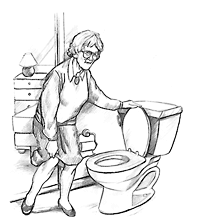 |
|
Damage to autonomic nerves from diabetes
can cause bladder and stomach problems.
|
- Autonomic nerves go to the bladder. Damage to these nerves can make it hard to know when you should go to the bathroom. The damage can also make it hard to feel when your bladder is empty. Both problems can cause you to hold urine for too long, which can lead to bladder infections. Another problem can be leaking drops of urine accidentally.
- Autonomic nerves go to the blood vessels that keep your blood pressure steady. Damage to these nerves makes your blood move too slowly to keep your blood pressure steady when you change position. When you go from lying down to standing up or when you exercise a lot, the sudden changes in blood pressure can make you dizzy.
 |
|
Diabetes can damage autonomic nerves that
help keep your blood pressure steady.
|
[Top]
How can diabetes damage to the cranial nerves affect me?
- Cranial nerves go to the eye muscles. Damage to these nerves usually happens in one eye, causing double vision. This problem happens all of a sudden and usually lasts for a short time.
- Cranial nerves go to the sides of the face. Damage to these nerves usually happens on only one side of the face. This nerve damage causes that side of the face to hang lower or sag. Usually the lower eyelid and lips sag. This problem is called Bell's palsy. It happens all of a sudden and tends to correct itself.
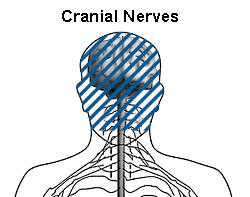 |
|
Cranial nerves go from your brain to your
eyes, mouth, ears, and other parts of your head.
|
[Top]
How do I know if I have nerve damage?
If you have one or more of the problems mentioned in this booklet, you may have some nerve damage from diabetes. Tell your doctor about the problem. Ask your doctor what you can do to make the problem better and to stop it from getting worse.
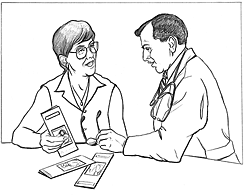 |
|
Ask your doctor what you can do about the
problems from diabetes nerve damage.
|
[Top]
For More Information
Diabetes Teachers (nurses, dietitians, pharmacists,
and other health professionals)
To find a diabetes teacher near you, call the American Association
of Diabetes Educators toll-free at 1-800-TEAMUP4 (1-800-832-6874),
or look on the Internet at www.diabeteseducator.org
and click on "Find a Diabetes Educator."
Dietitians
To find a dietitian near you, call the American Dietetic Association toll-free at 1-800-366-1655, or look on the Internet at www.eatright.org and click on "Find a Nutrition Professional."
Government
The National Institute of Neurological Disorders and Stroke (NINDS) is part of the National Institutes of Health. To learn more about nervous system problems, write or call the NIH Neurological Institute at P.O. Box 5801, Bethesda, MD 20824, 1-800-352-9424; or see www.ninds.nih.gov on the Internet.
To get more information about taking care of diabetes, contact
National Diabetes Information Clearinghouse
1 Information Way
Bethesda, MD 20892-3560
Phone: 1-800-860-8747 or (301) 654-3327
Fax: (301) 907-8906
Email: ndic@info.niddk.nih.gov
Internet: www.diabetes.niddk.nih.gov
National Diabetes Education Program
1 Diabetes Way
Bethesda, MD 20892-3600
Phone: 1-800-438-5383
Fax: (301) 907-8906
Internet: http://ndep.nih.gov
American Diabetes Association
1701 North Beauregard Street
Alexandria, VA 22311
Phone: 1-800-342-2383
Internet: www.diabetes.org
Juvenile Diabetes Research Foundation
International
120 Wall Street
New York, NY 10005-4001
Phone: 1-800-533-2873
Internet: www.jdrf.org
[Top]
More in the Series
The "Prevent
Diabetes Problems" series includes seven booklets that
can help you learn more about how to prevent diabetes problems.

For free single copies of these booklets, write, call, fax, or
email the
National Diabetes Information Clearinghouse
1 Information Way
Bethesda, MD 20892-3560
Phone: 1-800-860-8747 or (301) 654-3327
Fax: (301) 907-8906
Email: ndic@info.niddk.nih.gov
These booklets are also available at www.diabetes.niddk.nih.gov
on the Internet.
[Top]
Acknowledgments
The National Diabetes Information Clearinghouse thanks the people
who helped review or field-test this booklet.
|
For American Association of Diabetes Educators
Lynn Grieger, R.D., C.D.E.
Arlington, VT
Celia Levesque, R.N., C.D.E.
Montgomery, AL
Teresa McMahon, Pharm.D., C.D.E.
Seattle, WA
Barbara Schreiner, R.N., M.N., C.D.E.
Galveston, TX
For American Diabetes Association
Phyllis Barrier, M.S., R.D., C.D.E.
Alexandria, VA
Linda Haas, Ph.C., R.N., C.D.E.
Seattle, WA
Kathleen Mahoney, M.S.N., R.N., C.D.E.
Drexel Hill, PA
Randi Kington, M.S., R.N., C.S., C.D.E.
Hartford, CT
For Centers for Medicare & Medicaid Services
Baltimore, MD
Jan Drass, R.N., C.D.E.
For Diabetes Research and Training Centers
Albert Einstein School of Medicine Norwalk Hospital
Norwalk, CT
Jill Ely, R.N., C.D.E.
Sam Engel, M.D.
Pam Howard, A.P.R.N., C.D.E.
Indiana University School of Medicine
Indianapolis, IN
Madelyn Wheeler, M.S., R.D., F.A.D.A., C.D.E.
VA/JDF Diabetes Research Center
Vanderbilt School of Medicine
Nashville, TN
Ok Chon Allison, M.S.N., R.N.C.S., A.N.P., C.D.E.
Barbara Backer, B.S.
James W. Pichert, Ph.D.
Alvin Powers, M.D.
Melissa E. Schweikhart
Michael B. Smith
Kathleen Wolffe, R.N.
For Grady Health System Diabetes Clinic
Atlanta, GA
Ernestine Baker, R.N., F.N.P., C.D.E.
Kris Ernst, R.N., C.D.E.
Margaret Fowke, R.D., L.D.
Kay Mann, R.N., C.D.E.
For Indian Health Service
Albuquerque, NM
Ruth Bear, R.D., C.D.E.
Dorinda Bradley, R.N., C.D.E.
Terry Fisher, R.N.
Lorraine Valdez, R.N., C.D.E.
Red Lake, MN
Charmaine Branchaud, B.S.N., R.N., C.D.E.
For Medlantic Research Center
Washington, DC
Resa Levetan, M.D.
For Texas Diabetes Council
Texas Department of Health
Austin, TX
Luby Garza-Abijaoude, M.S., R.D., L.D.
|
[Top]
National Diabetes Information Clearinghouse
1 Information Way
Bethesda, MD 20892-3560
Email: ndic@info.niddk.nih.gov
The National Diabetes Information Clearinghouse (NDIC) is a service of
the National Institute of Diabetes and Digestive and Kidney Diseases (NIDDK).
The NIDDK is part of the National Institutes of Health under the U.S. Department
of Health and Human Services. Established in 1978, the clearinghouse provides
information about diabetes to people with diabetes and to their families,
health care professionals, and the public. NDIC answers inquiries, develops
and distributes publications, and works closely with professional and
patient organizations and Government agencies to coordinate resources
about diabetes.
Publications produced by the clearinghouse are carefully reviewed by both NIDDK scientists and outside experts.
This e-text is not copyrighted. The clearinghouse encourages users of
this e-pub to duplicate and distribute as many copies as desired.
NIH Publication No. 03-4284
September 2003
[Top]
|




